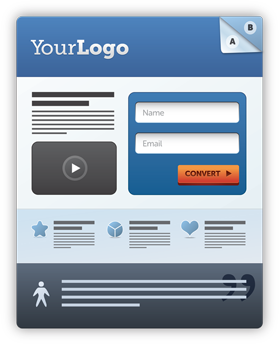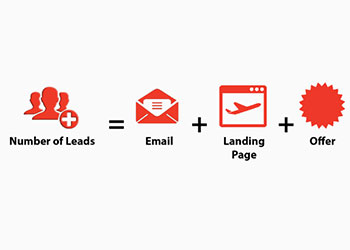7 Factors that will increase the conversions of your emails
The success of an email lead generation campaign is a long and complicated equation with a lot of variables. Each of these variables can change the performance of your campaign in greater or lesser extent.
So what are those variables?
We will go through all of them more precisely in the next posts but in this article we will only do a general look at the equation.
A successful campaign or the generation of a qualified lead depends on the quality of the email and the landing page, the attractiveness of the offer, the data required for each lead, the brand awareness of the advertiser, the industry of the advertiser and, of course, the budget allocated for that campaign.
Looking more like a maths equation, we could say that:

Email:
To create a successful email probably we would need to write another equation but don’t worry, this is not a maths lesson so I will just name those things that can make an email generate traffic to your offer:
Email address of the sender
A personal and recognizable or at least a believable email address will drive to more openings than a for example info@yourbrand.com.au
Subject line
We send and receive an average of 120 emails every day. Would you waste your time with an email that doesn’t say anything relevant stuff in the Subject? Not in my case and the 90% of the people. That means that if your subject line is not relevant and attractive, you will be probably losing around a 90% of the openings you could get.
Email Writing
You got their attention, now do your best to keep it up! Tell them what they want to hear, make a personalized message and make sure that your text drives them to the call to action.
Call To Action
It has to be clear, easy to see and what is more important, it has to be connected with what you will tell them in the landing page. For example, if the call to action says: “Click here and get your free sample”, don’t drive them to a landing page where there is no reference to that Free Sample. In that case you will get a fantastic click through rate but the bounce rate in your landing page will be very close to 100% probably. Avoid false or frustrating calls to action.
Links / buttons
The Call to action is a good place where to put your button or link to the landing page. What you need to make sure is that the buttons won’t be a mystery; we are not flirting with the users, so now it isn’t time to play cool hiding the links. We want them to find us easily and in any device.
Design
Some experts will say that this is the less important part of the email but from our point of view, a good design is like a good haircut and a nice outfit, it always helps to make the people look at you and why not? Get a little interested in you too!

Landing Page:
Rule number one of the good landing page: don’t surprise anyone. If you surprise the people that lands in your  landing page from an email, it means that they see something that they weren’t expecting, and we don’t want that.
landing page from an email, it means that they see something that they weren’t expecting, and we don’t want that.
We want them to know what are they clicking on, and once they do it, we want them to feel like they are exactly in the right place.
And Rule number two of the good landing page: finding the form to fill shouldn’t be a mission. If we want the users to fill a form and give us their details, we will need to make it easy for them.
Offer:
This is a simple point. Would you rather giving your details with the chance to win a Weekend in a Holiday Resort or for a Free sample of shampoo?
This will be an important decision before starting a campaign, you need to think about what will be interesting for your target, what will convince them to click on the offer and go through all the path.
Also, an offer can be a good segmentation tool. For example, if I’m a business school and I want only leads who are interested in Business, if I make an offer giving Free Flights to London, probably I will have more people who is not interested in Business signing up than if I offer a Free ebook about Business Management.
Form:
Depending on the fields we want the users to fill, our conversions will be higher or lower. Why? Because it’s not the same sharing your Name and your Email address than sharing your Name, Email address, Phone number and Postcode.
The number and type of fields we ask them should be:
– Accorded to our offer. If we say that we will offer them a free consultation, asking for their phone number won’t be as intrusive as if we say that we want to give them a free ebook.
– Achievable. We are in the fast-era. If something take us more than 30 seconds to do, we will probably give up before we finish it.
Brand:
A brand well known will be easier to trust that a new brand or a small brand. In that sense, small and new brands will have to do an extra effort in design to make sure that their communication and their offer looks trustworthy.
Industry:
Similar to the previous point, there are industries that are more likely to be trusted than others. Which ones are that?
If you are in the industry of Restaurants, you will need to work hard to get some clicks to your offers (average of 1.50% CTR).
Otherwise, if you are in the industry of Hobbies or Media & Publishing, you might have an average CTR of 5%.
Check this table provided by MailChimp that will give you a better understanding of how your Industry positions. http://mailchimp.com/resources/research/email-marketing-benchmarks/
Budget:
Finally, like in any other thing in this World, the money will make a difference too. But what matters for me is not the quantity; at the end, we can’t ask an advertiser to reproduce the money! So what for me really matters is how to maximize the results with the budget that we have.
As I said before, we will check closely one by one, all this points, in future articles. But this should give you an idea on how complicated is to make an email campaign work. For this reason, we always encourage people to ask experts to run Lead Generation campaigns. They will find the correct strategy for you to success, maximizing the value of your budget and converting it into qualified leads.
Related posts
What does a 2015 e-commerce strategy look like for brands? Well according the Melbourne Online Retailer and ecommerce conference held last week, ecommerce strategies involve smart marketing, should be all encompassing, and including a plethora of solutions and services. All of this combined helps to ensure that brands are competitive in this modern day ecommerce […]
Understanding emotions that affect purchasing behaviours is a key to ensuring brands succeed with their marketing budgets. Lets look at an example. Kmarts ‘Bom Bom Bom’ campaign and the discount ‘everyday low price’ strategy. Kmart worked to change consumer’s attitudes to the brand using the ‘Bom Bom Bom’ and on the emotions that drive consumption […]
After more than 6 years of experience, I get the same question again and again: How can we engage our email lists from the initial subscription and convert them all the way through to loyal customers? For that reason, we joined last week a a Webinar with Bob Kamal from Lyris HQ who presented on […]




 landing page from an email, it means that they see something that they weren’t expecting, and we don’t want that.
landing page from an email, it means that they see something that they weren’t expecting, and we don’t want that.

